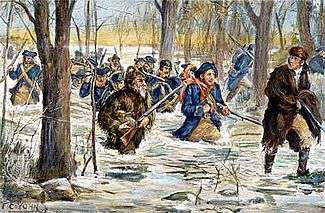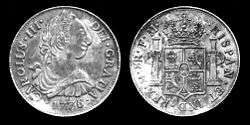John Duff (counterfeiter)
| John Duff | |
|---|---|
|
In the 1790s, John Duff and his criminal associate, Philip Alston, carried out their counterfeiting operation, in the relative seclusion of the wilderness, at Cave-in-Rock | |
| Born |
John Michael McElduff September 1759 - August 1760 Province of South Carolina, (British Royal Colony), British North America, British Empire, present-day South Carolina, US |
| Died |
June 4, 1799 or 1805 (aged 40-46) Battery Rock, Illinois Country, Northwest Territory, US, present-day Gallatin County, Illinois, Saline River Salt Springs, Illinois Country, Northwest Territory, US, present-day Gallatin County, Illinois, or Caseyville, Livingston County, Kentucky, present-day Crittenden County, Kentucky, US |
| Resting place | unknown |
| Nationality | American |
| Other names | Duff, John McDuff, Jean Duff, Jean Michel Duff, John Michael Duff, Michael Duff, Sergeant Duff, Duff the Counterfeiter |
| Occupation | frontiersman, hunter, horse thief, cattle thief, hog thief, soldier, salt maker, criminal gang leader, counterfeiter |
| Known for | Being a brave, Revolutionary War soldier, serving under George Rogers Clark, on the American western frontier and a notorious counterfeit money, on the Ohio and Mississippi Rivers |
| Spouse(s) | Letticia "Letty" or "Seddy" Smith, Native American woman, name unknown |
| Children | 1 child, name unknown, by Native American woman |
| Parent(s) | Thomas McElduff |
| Relatives | Daniel Duff (brother), Henry Smith (father-in-law), Margaret Smith (mother-in-law), Jean Baptiste St. Ange (brother-in-law), Sarah Smith St. Ange (sister-in-law), John Doyle (brother-in-law), Chloe Smith Doyle (sister-in-law) |
John Duff, born John McElduff, or possibly John Michael McElduff, because early court records referred to him as John Michael Duff (September 1759 or August 1760 – June 4, 1799 or 1805), was a counterfeiter, criminal gang leader, horse thief, cattle thief, hog thief, salt maker, longhunter, scout, and soldier who assisted in George Rogers Clark's campaign to capture the Illinois country, for the American rebel side, during the Revolutionary War. Duff also, was frontiersman, hunter, horse thief, cattle thief, soldier, salt maker, criminal gang leader, counterfeiter
Early life and family history
John Michael McElduff was born, sometime, between September 1759 and August 1760 in South Carolina, according to his court testimony in August 1781, when he was 21 years old. His father died and his mother remarried. John's father may have been the Thomas McElduff murdered by Philip McElduff, a brother, of Thomas, some time prior to November 1761. His stepfather moved the family to the Natchez, Mississippi region of the colony of British West Florida, on the Mississippi River, prior to the start of the American Revolutionary War. McElduff is believed to be a grandson of a Thomas McElduff, Sr., who received two land grants, for military service in the French and Indian War, on the south side of the Tyger River, in Union County, South Carolina on February 7, 1754.

Revolutionary War service and life in the Illinois Country
Around 1778, Duff was living in the Illinois Country or later, referred to as, the "American Bottom." While leading a group of longhunters returning to Kaskaskia, John Duff, John Saunders, and the rest of the hunting party were intercepted, by Colonel George Rogers Clark's soldiers and his Virginia frontiersmen soldiers, near the ruins of Fort Massac. Suspected of being British spies, they immediately, took an American oath of allegiance, where Duff and his men joined Clark's Illinois Regiment, Virginia State Forces. Duff enlisted into Captain John Williams' Company in Cahokia and rose to the rank of sergeant in the Illinois Regiment.

In 1780, John Duff, while posted with the garrison in Cahokia, the British attacked French creole, St. Louis, under colonial Spanish rule and American-held Cahokia in 1780, with a motley army of French-Canadians, fur traders, and their Indian allies. McElduff and other soldiers were on reconnaissance, for General Clark, observing the British movements, near the Mississippi River. The group was attacked by an Indian war party, barely escaping with their lives. The combined American, French, and Spanish forces successfully, repelled the enemy assaults. In the George Rogers Clark Papers and Illinois court records, Duff was referred to, interchangeably, as "John McElduff" and "John McDuff."
In the mid-late 1780s, Duff was living in Kaskaskia, Illinois and was in business with two brothers of the captain of the Ohio County, Virginia Militia and Revolutionary War Patriot, Samuel Mason who later, became the notorious river pirate. According to the French Kaskaskia records, the Duff name was recorded as, "Jean Michel Duff" and "John Michael Duff." In 1786, John and Daniel, and another son of Thomas McElduff, sold land tracts for two different property deeds. There was a Daniel McElduff and McDuff who was also, at Kaskaskia in the 1780s and was likely, the brother of John Duff. When the McElduffs first arrived in the pre-American Revolution, British-controlled, French-speaking settlement of Kaskaskia was not recorded. Daniel McDuff owned slaves while, residing in Kaskaskia, as was the custom of transplanted Southerners and the French creole population in the Illinois Country. After the departure, of the, 1784-1790 dictatorship rule, of bandit, John Dodge, John McElduff was elected, in 1790, as one, of six judges, to the Kaskaskia town court. According to the French records, on February 6, 1794, John McElduff and Seddy, his wife, sold a dwelling and grounds, in Kaskaskia Village, to J.R. Jones for $200; this Jones may have been John Rice Jones, an Illinois Regiment veteran, noted politician, and the first lawyer in the Illinois Country.

Counterfeiting at Cave-In-Rock, Northwest Territory and in Kentucky
After 1790, John Duff was associated with the South Carolina counterfeiter, Philip Alston, the Virginia river pirate, Samuel Mason, and the North Carolina serial killers, the Harpe brothers, at Cave-in-Rock, in the U.S. Northwest Territory, where he learned the illicit business of counterfeiting, known as "coining," and he could make a lot money in criminal pursuits. By this time, he had left the historical record and from this point on, he was referred to in folklore as, just Duff or "Duff the Counterfeiter." Even as a counterfeiter, John Duff was not a violent man, by nature and he was never known to have killed anyone, while a criminal. If John McElduff and his wife, Seddy left Kaskaskia, permanently, after 1794, is not known but, folklore mentioned John Duff, as owning a slave named Pompey and tales of his miraculously avoiding, numerous attempts at, capture and death from local, regulator vigilantes and the U.S. Army.
Death
For nearly, a decade, Duff had become a scourge along the lower Ohio River region. On June 4, 1799, a group of three Shawnee Indians and a French courier du bois were hired by U.S. Army officer, Captain Zebulon Pike, Sr., father of the explorer, who was the commandant, at the frontier outpost, of Fort Massac, now Metropolis, Illinois. This mercenary party was given orders to kill John Duff, which they did, at his house which, was located either at Battery Rock, according to the newspaper account, on the Illinois side of the Ohio River or across the river at what would later, become Caseyville, Kentucky as, recalled in the History of Union County, Kentucky. According to Revolutionary Soldiers Buried in Illinois, Duff was killed, in 1805, on Ripple Island, on Saline River, in Gallatin County, Illinois and buried near the local salt springs.

References
- Alvord, Clarence Walworth. The Illinois Country, 1673-1818, Volume 1. Springfield, Ill.: Illinois Centennial Commission, 1920.
- Alvord, Clarence Walworth, editor. Kaskaskia Records, 1778-1790, Collections of the Illinois State Historical Library, Illinois State Historical Library. Springfield, Ill.: Trustees of the Illinois State Historical Library, 1909.
- Bateman, Newton and Paul Selby, editors. Biographical and Memorial Edition of the Historical Encyclopedia of Illinois, Volume 1. Munsell Publishing Company, 1915.
- Reynolds, Governor John. The Pioneer History of Illinois: Containing the Discovery, in 1673, and the History of the Country to the Year 1818, when the State Government was Organized. Fergus Print Company, 1887.
- Rothert, Otto A. The Outlaws of Cave-In-Rock. Cleveland: 1924; rpt. 1996 ISBN 0-8093-2034-7
- Seineke, Kathrine Wagner Seineke. The George Rogers Clark adventure in the Illinois: and selected documents of the American Revolution at the frontier posts. New York: Polyanthos, 1981.
- Underwood, Lt. Thomas T. "The journal, 1792-1800, of Thomas T. Underwood, lieutenant in the United States Army, life at Fort Massac (Illinois) under Zebulon M. Pike's command (1795-1798)," Draper Manuscripts: Frontier Wars Papers, 1754-1885 (Volume 16). Wisconsin Historical Society, Library-Archives Division.
- Walker, Mrs. Harriett J. Revolutionary Soldiers Buried in Illinois. Standard Printing Company, 1918.
- Wellman, Paul I. Spawn of evil: the invisible empire of soulless men which for a generation held the Nation in a spell of terror. New York: Doubleday, 1964.
- Willson, Richard Eugene, Indexing, Donald E. Gradeless, Ph.D., Editor. 1998. Index to the George Rogers Clark Papers: The Illinois Regiment. Based on the Microfilmed George Rogers Clark Papers at the Virginia State Library and Archives. Chicago: Society of Colonial Wars in the State of Illinois.
- Chester Co (South Carolina) Misc Record Book LL, reprieve granted Philip McElduff convicted of murder of Thomas McElduff till Wed the 2nd of Dec 1761, p.417
- History of Union County, Kentucky. Chicago: Goodspeed Publishing Co., 1886.
- New Bern District (North Carolina) Court Records 1770-1774 http://files.usgwarchives.net/nc/craven/court/nbdcr2.txt
- Papers of the U.S. War Department 1784-1800 http://wardepartmentpapers.org/about.php
- Raymond H. Hammes Collection. English Summaries. Illinois State Archives. 81:2:27:1.
- "Some Irish Protestant Immigrants to South Carolina 1753 and 1754," The South Carolina Magazine of Ancestral Research, Vol. 17, No. 1 (Winter 1989):25-29. FHL Book 975.7 B2sc v.
